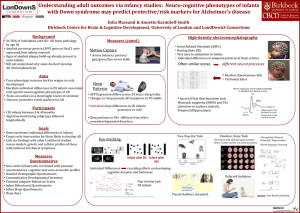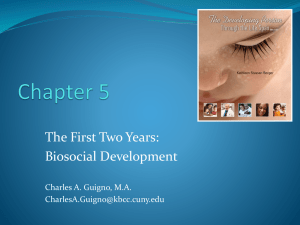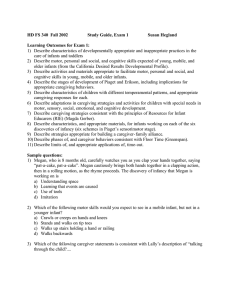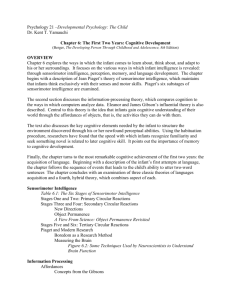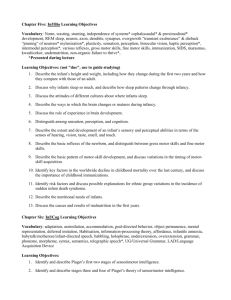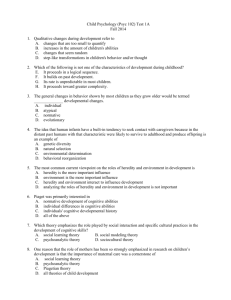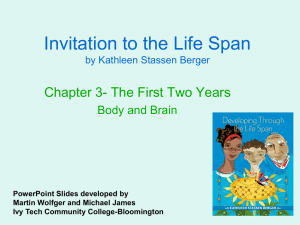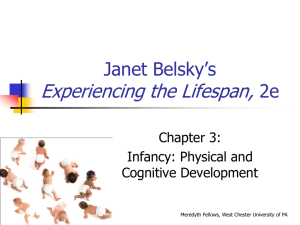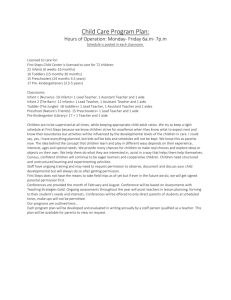Chapter 3
advertisement
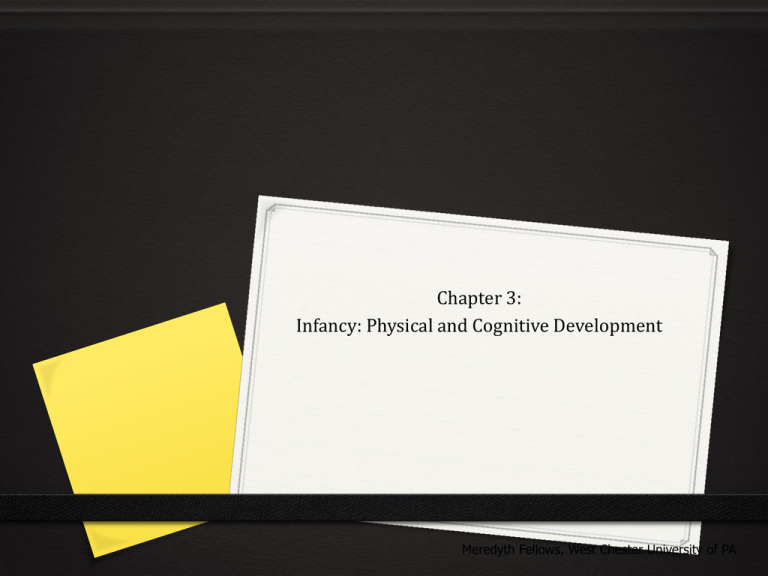
Chapter 3: Infancy: Physical and Cognitive Development Meredyth Fellows, West Chester University of PA The Expanding Brain 0 Cerebral Cortex 0 Outer furrowed mantle of brain 0 Site of every conscious perception, action, thought 0 Influences behavior a few months after birth 0 Brain volume quadruples during first 4 years The Expanding Brain 0 Neurons formed during fetal period 0 After birth, synaptogenesis occurs 0 Proliferation of connections at the synapses (often referred to as exuberant synaptogenesis) 0 Pruning follows 0 Myelination: formation of fatty layer encasing axons 0 Visual cortex myelinated by 1 year 0 Frontal lobes, age 20 or beyond Neural Pruning and Plasticity 0 Plasticity: The brain is “plastic” (malleable) during early childhood before pruning is complete. 0 Plasticity allows other brain regions to compensate following injury. 0 Brain is less plastic following childhood. Basic Newborn States: Reflexes 0 Reflexes: Sucking, Rooting, Grasping 0 Automatic responses or actions programmed by noncortical brain centers 0 Present at birth; promote survival Nutrition: Breast Milk • Recommended for first 6 months ▫ Protects from diseases ▫ Correlational studies show that breast-fed babies: are more alert during first 2 weeks experience fewer gastrointestinal problems and middle ear infections are more resistant to colds and flu appear to be superior in later measures of intelligence in elementary school Crying: First Communication Signal 0 Crying: 0 peak at about 5 weeks 0 Reflex dominated before the cortex is “on-line” at 4 months 0 Vital to survival (responsive parenting is a must!) Sleeping: Main Newborn State 0 Newborns, sleep 18 hours a day 0 90% of time in sleep or drowsy state 0 Unlike adult sleep cycle, newborns drop immediately into REM sleep. 0 Wake every 3-4 hours Sleep Cycles Brain-wave patterns and lifespan changes in sleep and wakefulness Intervention: Self-Soothing 0 Bidirectional influences: Sleep deprivation contributes to irritability in both parents and the infant. 0 By 6 months, upon waking, infants can self-sooth. 0 What do experts suggest? 0 Erikson & Bowlby: sensitively respond to crying infant during first year 0 Behaviorists disagree: Do not respond! 0 Ultimately the decision is yours! Sensory and Motor Development 0 Hearing 0 In the womb, fetuses can discriminate different tones 0 Smell 0 Within the 1st week, infants prefer smell of breast milk 0 Taste: 0 Infants stop sucking and wrinkle face in response to bitter, sour, or salty tastes 0 Avidly suck on sweet solutions 0 Pain management technique - have infant suck on sweet substance Focusing on Faces 0 Prefer faces to other stimuli, especially mother’s face 0 Prefer attractive-looking people 0 Infants mimic facial expressions Newborns looked most at the face-like drawing. Are we biologically programmed to selectively look at faces? Depth Perception: the Visual Cliff Experiment 0 When 8 month-old babies begin to crawl, they perceive differences in depth and fear heights. 0 Notice survival response! Visual Cliff Expanding Body Size and Motor Milestones 0 Growth is most pronounced in infancy, slows down during childhood, increases during preadolescence 0 Motor Milestones 0 Cephalocaudal: lift head, pivot upper body, sit up, stand 0 Proximodistal: control of shoulders before control of arms and fingers 0 Mass-to-Specific: gross motor skills before fine motor skills 0 Importance of myelination Cognitive Development: Piaget 0 Stage Approach 0 Studied his own children 0 Schemas 0 Assimilation 0 Accommodation 0 Adaptation Circular Reactions: Sensorimotor Stage 0 Repetitive action-oriented schemas (habits) 0 Through circular reactions, the infant explores and incorporates new information into existing schemas. 0 Primary Circular Reactions 0 The infant’s first habits (body-centered) 0 Secondary (about 4 months to 1 year) 0 Infant explores environment 0 Tertiary (begin about 1 year) 0 “Little scientist” activities (baby explores the properties of objects) When Infants Begin to Think: Sensorimotor Stage 0 Evidenced by 0 Deferred imitation: 0 When infant repeats an action observed at an earlier time 0 Means−end behavior: 0 Occurs about 1 year, when infant performs a different or separate action to reach a goal 0 Limitation in Thinking: A-not-B error: 0 Approaching year 1, even though a baby sees an object hidden in a second hiding place, he/she returns to the originally viewed hiding place to find it! Object-Permanence: Sensorimotor Stage 0 Understanding that objects exist even when out of sight 0 Around 5-6 months, infants begin to look for hidden objects. 0 At about 8 months infant develops object permanence (“little-scientist stage”). Critiquing Piaget and a New Perspective 0 Understanding of physical reality emerges gradually, not in unitary, qualitatively different stages as Piaget believed. 0 New perspective: information-processing 0 A perspective on understanding cognition that divides thinking into specific steps and component processes, much like a computer Emerging Infant Social Cognition 0 Social Cognition: any skill related to understanding feelings and negotiating interpersonal interactions. 0 We make inferences about people’s inner feelings and goals, based on their actions. 0 Research suggests this begins as early as 5 months. 0 Joint Attention 0 This is the first sign of “getting human intentions” when a baby looks at an object to which an adult points or the infant follows a person’s gaze. Language: Basic Principles 0 Noam Chomsky’s nature-oriented concept: LAD, Language Acquisition Device 0 Hypothetical brain structure that enables our species to learn and produce language 0 Unique to our human species 0 Chomsky’s concept is in opposition to Skinner’s nurtureoriented perspective. 0 We learn language by being reinforced for producing specific words. Language: Basic Principles 0 The specific language learned is dependent on nurture—the place where you were reared. 0 Presently, the social-interactionist view: 0 Interactions between baby and caregivers—each wants to communicate, one encourages the other 0 Emphasis on the social function of language
